Plan checklist
Moodey
103 Onderdonk Lane, Carrying Place, Bay Of Quinte
Planting plan created by Watersheds Canada
Schedule A:
Plants & Property
Land Characteristics
This planting plan is designed based on the land characteristics identified during the day of the site visit. Plants are chosen according to the soil and light conditions on your property. The number of plants chosen for each planting compartment takes into account the square metre area of the space, as well as the amount of current vegetation cover.
Land Characteristics by Compartment
| Length | Width | Area | pH | Soil | Moisture | Light | Height | |
|---|---|---|---|---|---|---|---|---|
| A | 2m | 1.5m | 3m2 | normal | loamy | normal, moist | full sun, partial sun | any |
| B | 9m | 4m | 36m2 | normal | loamy | normal, moist | full sun, partial sun | any |
| C | 17m | 4m | 68m2 | normal | loamy | moist, wet | full sun, partial sun | any |
| D | 15m | 4m | 60m2 | normal | loamy | moist, wet | full sun, partial sun | any |
| E | 3m | 6m | 18m2 | normal | loamy | normal, moist | full sun, partial sun | any |
| 46m | 3.9m | 185m2 |
Plant Selection Summary
The following shrubs and trees are chosen for their suitability and survivability given the current soil and light conditions in each compartment on your property, as well as preferable features.
| Plant Species | A | B | C | D | E | Potted | Bareroot | Wildflower |
|---|---|---|---|---|---|---|---|---|
| Black Willow | 1 | 1 | 1 | 3 | ||||
| Canadian Serviceberry | 1 | 6 | 4 | 3 | ||||
| Swamp Milkweed | 3 | 3 | ||||||
| Ninebark | 3 | 8 | 6 | 5 | ||||
| Black Chokeberry | 6 | 6 | ||||||
| Narrow Leaved Meadowsweet | 9 | 9 | ||||||
| Nannyberry | 9 | 3 | 6 | |||||
| Buttonbush | 9 | 9 | 6 | 12 | ||||
| Pussy Willow | 3 | 3 | 6 | |||||
| Bebb Willow | 3 | 3 | 6 | |||||
| Gray Dogwood | 3 | 3 | ||||||
| Red Osier Dogwood | 12 | 12 | ||||||
| Black Elderberry | 3 | 3 | ||||||
| Sweet Gale | 9 | 3 | 6 | |||||
| Swamp Rose | 5 | 5 | ||||||
| Cardinal Flower | 6 | 6 | ||||||
| Silver Maple | 1 | 1 | ||||||
| Subtotal | 5 | 19 | 39 | 38 | 16 | 49 | 59 | 9 |
| Totals | 117 | |||||||
Plant Information
The following table summarizes key information about each plant selected for your property.
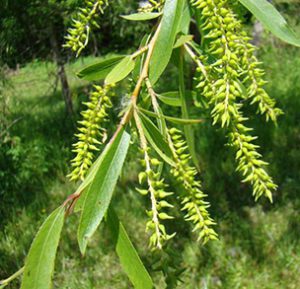
|
Black WillowHeight: 20 m
Black Willow is the largest native Willow species within North America. This species is considered to be a small to medium sized tree, typically growing 10-20 m in height, with a broad, spreading, and irregular crown. The trunk is large, crooked, often forked or sprouting, and covered in a dark black or brown scaly bark. The leaves are narrow, lance shaped, alternately arranged, and have finely toothed margins. Small green or yellow flowers bloom on catkins during the spring. By mid-summer, flowers turn into a cottony fruit. The Black Willow is a fast growing tree, reaching maturity within 30 years. It has a significant, shallow, spreading root system, which makes it an excellent tree to plant for erosion control and to stabilizing loose soil along shorelines. However, as with most Willows, do not plant near septic system, sewers, or wells because the roots can cause damage.
|
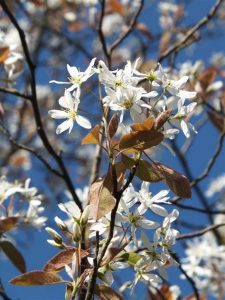
|
Canadian ServiceberryHeight: 3-5 m
The Canadian Serviceberry is a multi-stemmed shrub or small tree which grows from 3-5 m in a dense round form. This plant may also be known by the common names: Juneberry, Shadblow, or Shadbush. Early in the spring, prior to leaf development, clusters of fragrant, showy white flowers bloom along the branches. By July, these flowers give way to the fruiting bodies. The fruits are initially small, green berries, which grow to the size of blueberries and turn a deep purple-blue upon maturation during the fall. Leaves produced are finely toothed and spear-shaped. Throughout the summer, leaves are dark green and turn a dramatic orange-red during the fall.
|
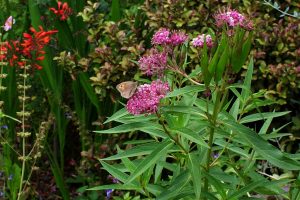
|
Swamp MilkweedHeight: 1 m
Swamp Milkweed is a beautiful wildflower species that typically grows about 1 m tall. The leaves are light green coloured, narrow, lance shaped, and oppositely arranged. The flowers are showy, fragrant, bright pink, appear in clusters on flowering stems, and bloom between July and August. The flowers give way to large, long and narrow, brown seed pods, which produce an abundance of seeds with tufts of long, white hairs. The flowers are beneficial to pollinator species, like bees and butterflies. As with all Milkweeds, the stem exudes a milky sap when broken, however the sap of the Swamp Milkweed is less milky than other species. This sap is critical for caterpillars of the endangered Monarch Butterfly to deter predators.
|
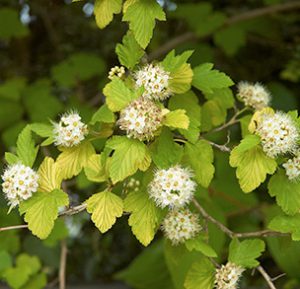
|
NinebarkHeight: 2-3m
The Common Ninebark is a very hardy, large (2-3m in height), deciduous shrub naturally occurring within riparian zones. This species is often planted as an ornamental shrub for its exfoliating bark which reveals reddish-light brown inner bark. This shrub is multi-stemmed with numerous horizontal and ascending branches creating a full, round shape. The Common Ninebark produces dull green, ovate to round shaped leaves with three to five lobes per leaf. During the fall the leaves turn brilliant yellow or dark purple. Between May and June, showy, bell-shaped flowers bloom in clusters on the terminal ends of the branches. During the summer, these flowers give way to small green or green-yellow berries which turn a bright red upon ripening.
|
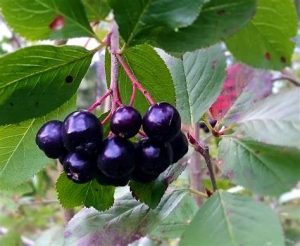
|
Black ChokeberryHeight: 1-3m
The Black Chokeberry is a medium sized deciduous shrub that typically grows between 1-3m with edible fruit. This species requires full sun to partial shade and can tolerate soil conditions from loamy and moist to rocky and dry. Naturally, Black Chokeberry is found in wet wooded areas such as; swamps, along shorelines, and within forest understory. This species is multi-stemmed, and forms thickets from stems which arise from the roots. Leaves are simple, growing alternately along the branch turning a bold red to orange during the fall. During spring, clusters of showy, white flowers appear turning into dark purple berries by fall. This species is resistant to drought, insects, pollution, and disease. The Black Chokeberry is often cultivated as an ornamental plant and food product. Additionally, this species is useful for bank stabilization and erosion control applications.
|
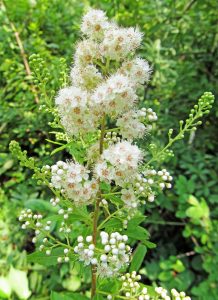
|
Narrow Leaved MeadowsweetHeight: 1-2m
The Narrow Leaved Meadowsweet is an erect, deciduous shrub, which grows in the shape of a mound to a height of 1-2m. This species develops numerous branches and branchlets, giving it a sparse appearance. Leaves produced are simple and narrow with sharply toothed borders growing alternately along the branches. These bright, light green leaves appear crowded, as they grow close together on the stocks and branches. During the fall, leaves turn a yellow-red or yellow-orange colour. Small white to light pink flower clusters appear in the spring growing in a dense, narrow pyramid at the terminal ends of the branches. During late summer to early fall, these flowers produce smooth, papery seed pods.
|
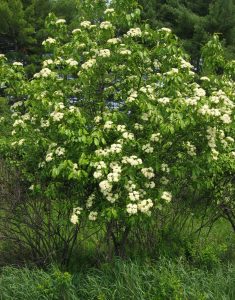
|
NannyberryHeight: 3 m
Nannyberry is a large deciduous shrub species that typically grows about 3 m in height. The leaves are dark green, ovate shaped, oppositely arranged, have a pointed tip, and have finely toothed margins. The flowers are showy, white colored, appear in flat topped clusters, and bloom in May. These flowers produce blueish black berries, which are edible to humans and persist throughout the winter. The flowers are beneficial to pollinator species , like bees and butteries. The fruit is beneficial to wildlife species, including birds and small mammals. This shrub has attractive fall foliage. The root system is extensive, making this plant valuable for controlling erosion and stabilizing loose soil. This shrub can be pruned to have a single stem and grown as a small tree instead of a shrub.
|
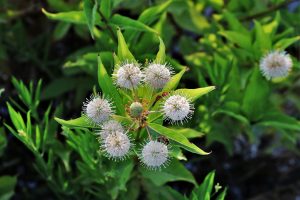
|
ButtonbushHeight: 2 m
Buttonbush is a small to medium-sized deciduous shrub species which typically grows about 2 m in height. This plant may also be known by the common name Button Willow. Twigs are slender to stout and dark red-brown in colour with white speckling. The leaves are bright green coloured, shiny, ovate shaped, oppositely arranged, and have entire margins. The flowers are tiny, tubular, white, fragrant, and appear densely on distinctive, spherical clusters in June. These flowers turn into a dense cluster of seeds, which remain on the plant throughout the winter. The flowers are beneficial for pollinator species, including hummingbirds and butterflies. This is a hardy, adaptable species and an excellent choice for planting on wet shoreline sites.
|
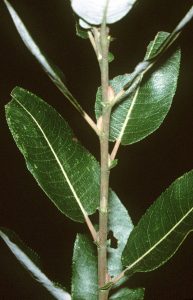
|
Pussy WillowHeight: 6m
The Pussy Willow is a fast growing, deciduous shrub or small tree found reaching heights of 6m, and is from British Columbia to Newfoundland. This species grows from shoots extending from the base of the trunk, creating a multi-stemmed, tall, round bush. The Pussy Willow is an ideal species for bank stabilization and erosion control due to its large, fibrous root system and love of water. This species branches extend from the main shoots and are usually hairy and reddish-brown in colour. The main shoots of Pussy Willow are smooth and greyish-brown, becoming scaly with age. It produces simple, narrow, lance-shaped leaves alternately arranged along the branch. The Pussy Willow yields purple-brown fuzzy catkins which will form long-beaked and finely haired capsules during May and June.
|
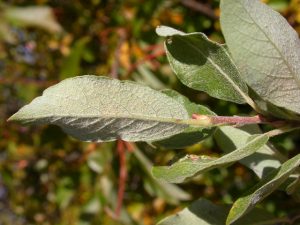
|
Bebb WillowHeight: 5 m
The Bebb Willow is a mid-sized deciduous shrub species that can grow up to 5 m in height. This plant may also be known by the common names Beaked Willow and Diamond Willow. The leaves are alternately arranged, dull green in colour, have wrinkled and hairy undersides, are narrow and elliptic in shape (but broad for willow), and have toothed margins. The bark is reddish or grayish-brown in colour and may have diamond-shaped patches along the main stems. The catkins are light green or yellow coloured and appear with the leaves between May and June. The roots can useful for controlling erosion and stabilizing shorelines.
|
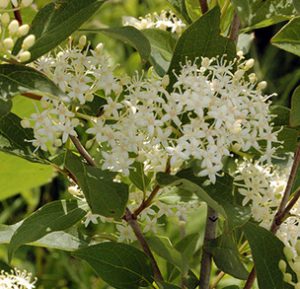
|
Gray DogwoodHeight: 2-3m
The Gray Dogwood, also referred to as Northern Swamp Dogwood or Panicle Dogwood, is a medium-sized, deciduous shrub which typically grows 2-3m. This species is multi-stemmed, with a full, round form. The leaves are green and arranged alternately along the branches. During the fall, leaves turn a bright red to deep purple colour. Between May and June, showy clusters of small white flowers bloom. These flowers turn into white fleshy berries late in the summer. The reddish-pink stems hold the berries throughout the winter, creating an artful contrast to the gray bark and snowy scenery. The Gray Dogwood is tolerant of a variety of environmental conditions and its complex, fibrous root system make it an ideal plant to use for controlling erosion.
|
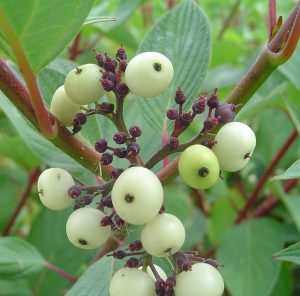
|
Red Osier DogwoodHeight: 1.5-4m
The Red Osier Dogwood is a medium-sized, deciduous shrub native throughout Northern and Western North America which typically grows to 1.5-4m. This species is multi-stemmed with numerous erect and ascending bright red branches that create a loose and spreading form. Leaves produced are simple, two-toned with a dark green upper side and light green underside. They are arranged opposite each other along the branches. During the fall, the foliage turns a brilliant red to dark purple. Clusters of small, creamy white flowers form on the terminal ends of the branches between June and July. The Red Osier Dogwood produces blueish-white fruiting bodies during late summer, which may persist throughout the winter. This shrub's berries provide an important winter food source for numerous species, from large deer to small wintering birds.
|
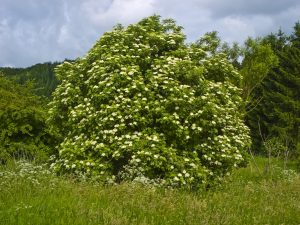
|
Black ElderberryHeight: 4 m
The Black Elderberry is a large, fast-growing, deciduous shrub or small tree, which typically grows to 4m. This species tolerates a variety of conditions and is commonly found in sunny locations with well-drained soils. Black Elderberry can be single or multi-stalked with numerous branches creating a full, round body. Leaves are compound, with 5-7 leaflets that grow opposite each other along the branch. During the fall, leaves tend to turn a pale yellow. During late May to early June, this species produces flowers that are ivory white and grow in flat topped clusters. By late August, flowers turn to glossy, deep purple fruit, which attract a variety of wildlife like songbirds and small mammals. Ripe fruit is edible for humans and is commonly made into jams and jellies. The root system of this species is shallow, and can form colonies through suckering.
|
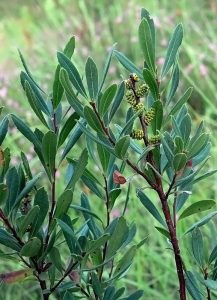
|
Sweet GaleHeight: 1-2m
Sweet Gale is a medium-sized shrub which grows into a thick bush about 1-2 m tall. This species produces 1-8 cm long, oblong-lanceolate leaves which are finely toothed at the tip and are spirally arranged. When bruised, these leaves give off a pleasant aroma. Male and female catkins are produced on separate plants. The seeds are dispersed from the female plants via water, as they float on two corky bracts. This shrub also provides a good food source for bird species that eat the seeds including Grouse, Chickadees, and Bluebirds. Mammal species like Beavers and White-Tailed Deer also browse on the twigs and leaves of this plant.
|
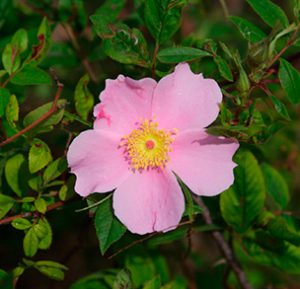
|
Swamp RoseHeight: 2m
The Swamp Rose is a beautiful perennial shrub species that typically grows 2m in height and spreads 2m. It is visually appealing with large pink flowers that last about 6-8 weeks. These flowers have five pink petals, a yellow center, and a pleasant fragrance. This species produces oblong shaped, compound leaves comprised of seven leaflets with serrated edges. The Swamp Rose produces red, round, fleshy fruit called rose hips, which remain on the bush throughout winter. These fruiting bodies provide a winter food source for wildlife, such as Grouse, Black Bears, Deer, and Rabbits. Swamp Rose may be confused with Prickly Wild Rose, which has a similar appearance. However, Swamp Rose can easily be distinguished by the presence of curved thorns, which appear at the nodes of the twigs without any occurring between the nodes. Swamp Rose grows best in moist, rich soils such as swamps and marshy shorelines. However, this species can also tolerate drier, loamy soils.
|
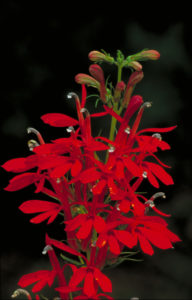
|
Cardinal FlowerHeight: 1 m
Cardinal Flower is an attractive herbaceous perennial wildflower that can grown up to 1 m tall. The leaves are mostly basal, dark green, lance shaped, alternately arranged, and have finely toothed margins. The flowers are showy, bright cardinal red colored, tubular with five lips, appear on an erect terminal spike, and bloom between July and September. The flowers are beneficial for pollinator species, like butterflies and hummingbirds. This is a popular plant choice for wet shoreline properties because of its visual appeal and ornamental value.
|
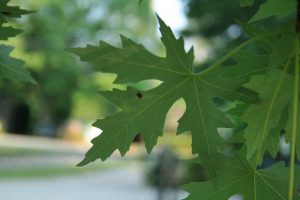
|
Silver MapleHeight: 30m
The Silver Maple is a fast growing, deciduous Maple tree famous for its majestic, mature form. This species has a broad, round crown that sits on top of a tall straight trunk reaching 30m in height. Its ascending branches give this tree a full, bushy appearance. Silver Maple leaves can be differentiated from other Maple leaves due to the deep notches on their lobes. It has a silvery white colour on its underside in contrast to bright, light green topside. During the fall, the leaves on the Silver Maple turn a reddish orange to bright golden yellow. Between late April and May, inconspicuous, small greenish red flowers bloom and by June turn to yellowish-green or brownish pairs of winged keys. The Silver Maple's shallow, spreading root system and ability to withstand flood and drought make it an excellent tree to utilize for erosion control and shoreline stabilization.
|
Compartment A
Naturalization Area
 pH: normal
pH: normal Depth: potted, bareroot
Depth: potted, bareroot-
 Moisture: normal, moist
Moisture: normal, moist -
 Soil Type: loamy
Soil Type: loamy  Plant Height: any
Plant Height: any-
 Light conditions: full sun, partial sun
Light conditions: full sun, partial sun
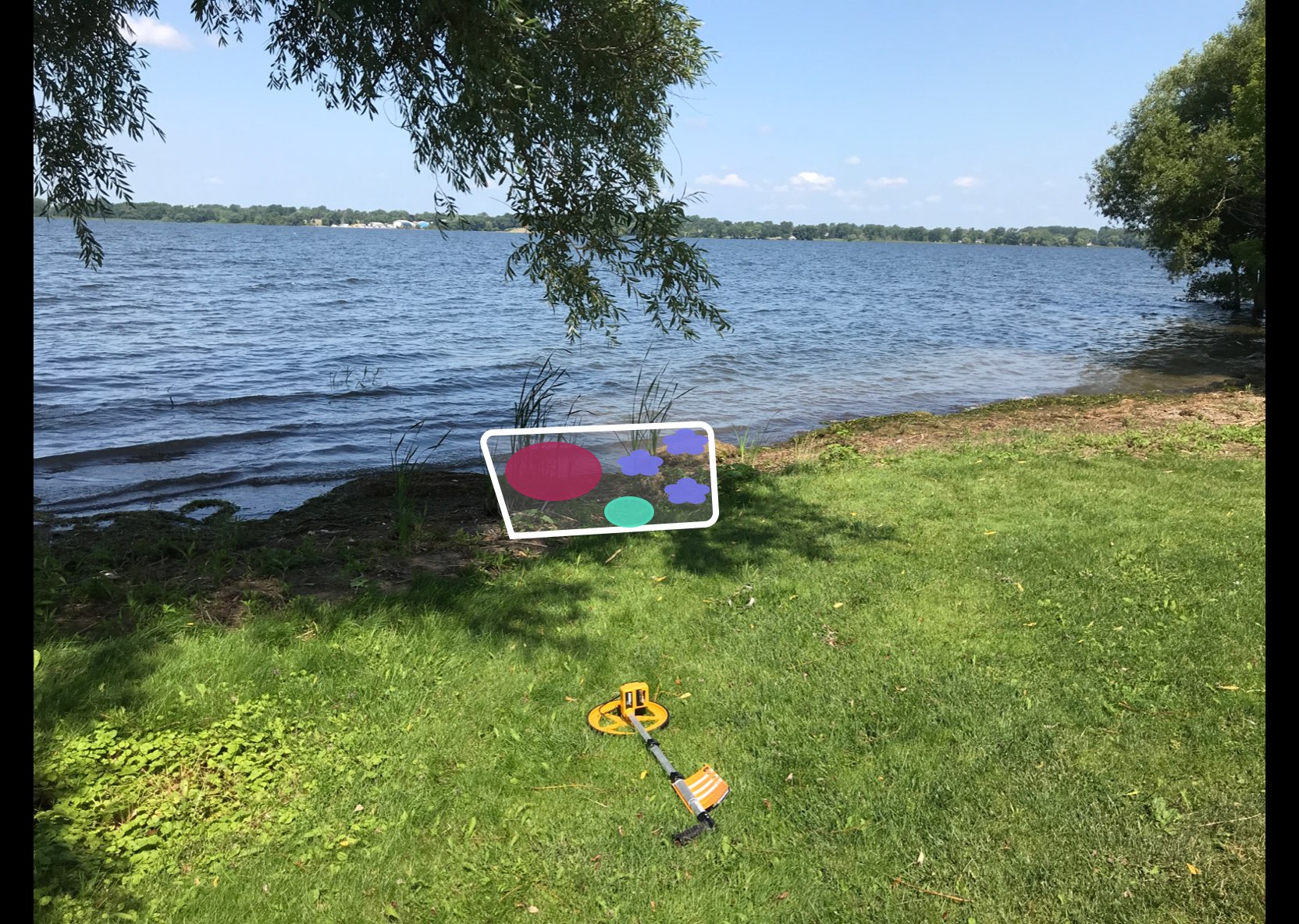
Compartment B
Naturalization Area
 pH: normal
pH: normal Depth: potted, bareroot
Depth: potted, bareroot-
 Moisture: normal, moist
Moisture: normal, moist -
 Soil Type: loamy
Soil Type: loamy  Plant Height: any
Plant Height: any-
 Light conditions: full sun, partial sun
Light conditions: full sun, partial sun

Compartment C
Naturalization Area
 pH: normal
pH: normal Depth: potted, bareroot
Depth: potted, bareroot-
 Moisture: moist, wet
Moisture: moist, wet -
 Soil Type: loamy
Soil Type: loamy  Plant Height: any
Plant Height: any-
 Light conditions: full sun, partial sun
Light conditions: full sun, partial sun
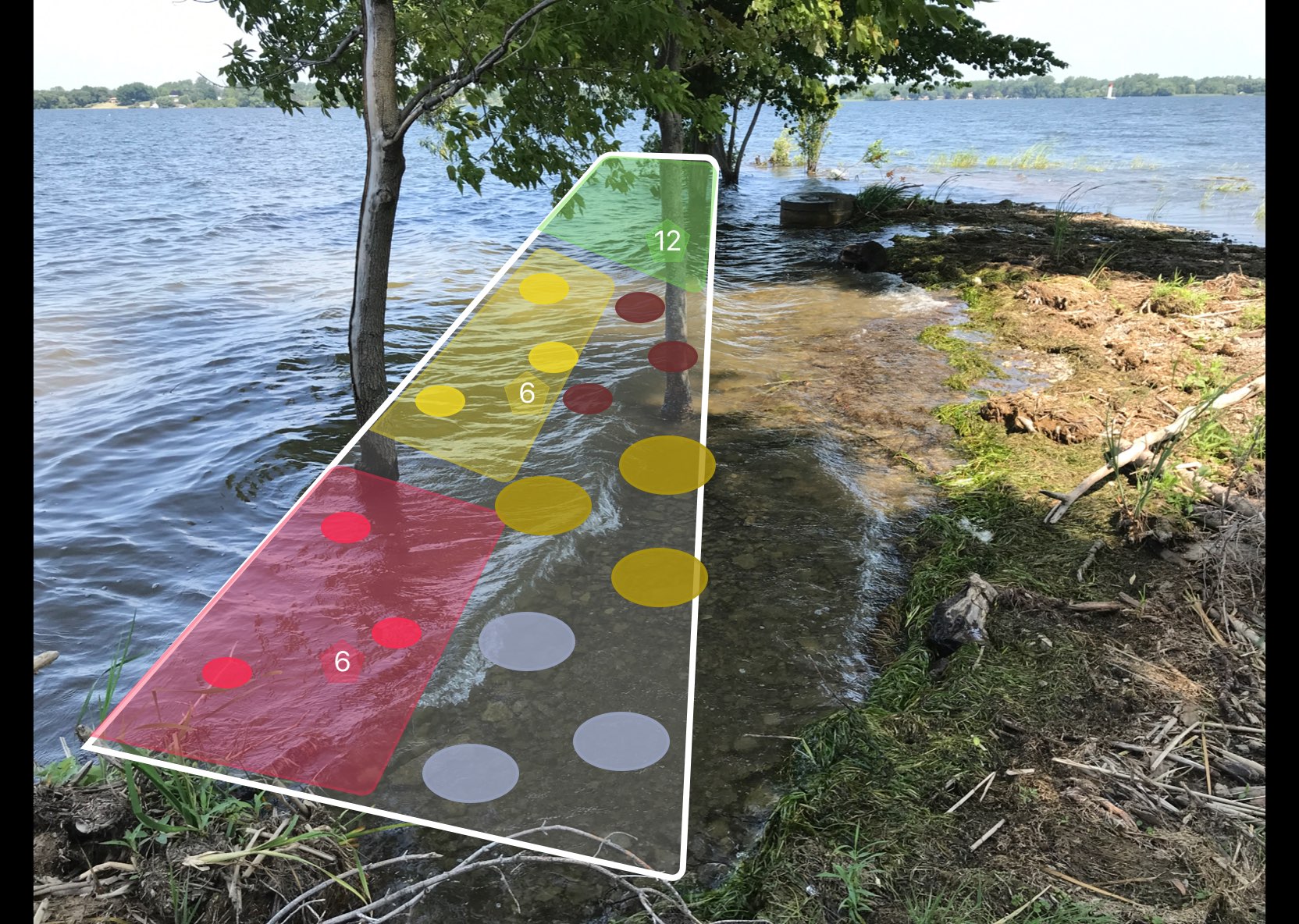
Compartment D
Naturalization Area
 pH: normal
pH: normal Depth: potted, bareroot
Depth: potted, bareroot-
 Moisture: moist, wet
Moisture: moist, wet -
 Soil Type: loamy
Soil Type: loamy  Plant Height: any
Plant Height: any-
 Light conditions: full sun, partial sun
Light conditions: full sun, partial sun
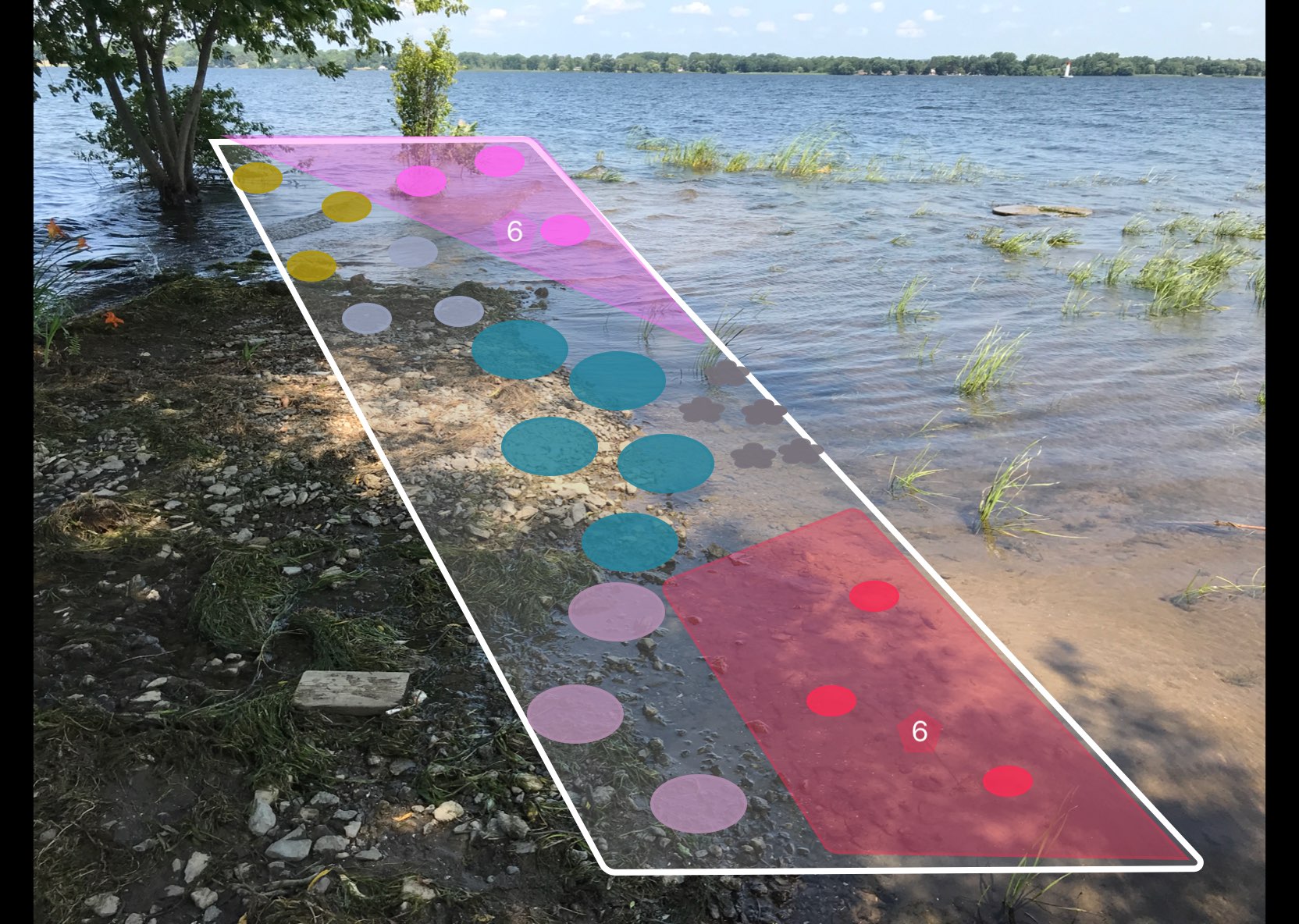
Compartment E
Naturalization Area
 pH: normal
pH: normal Depth: potted, bareroot
Depth: potted, bareroot-
 Moisture: normal, moist
Moisture: normal, moist -
 Soil Type: loamy
Soil Type: loamy  Plant Height: any
Plant Height: any-
 Light conditions: full sun, partial sun
Light conditions: full sun, partial sun
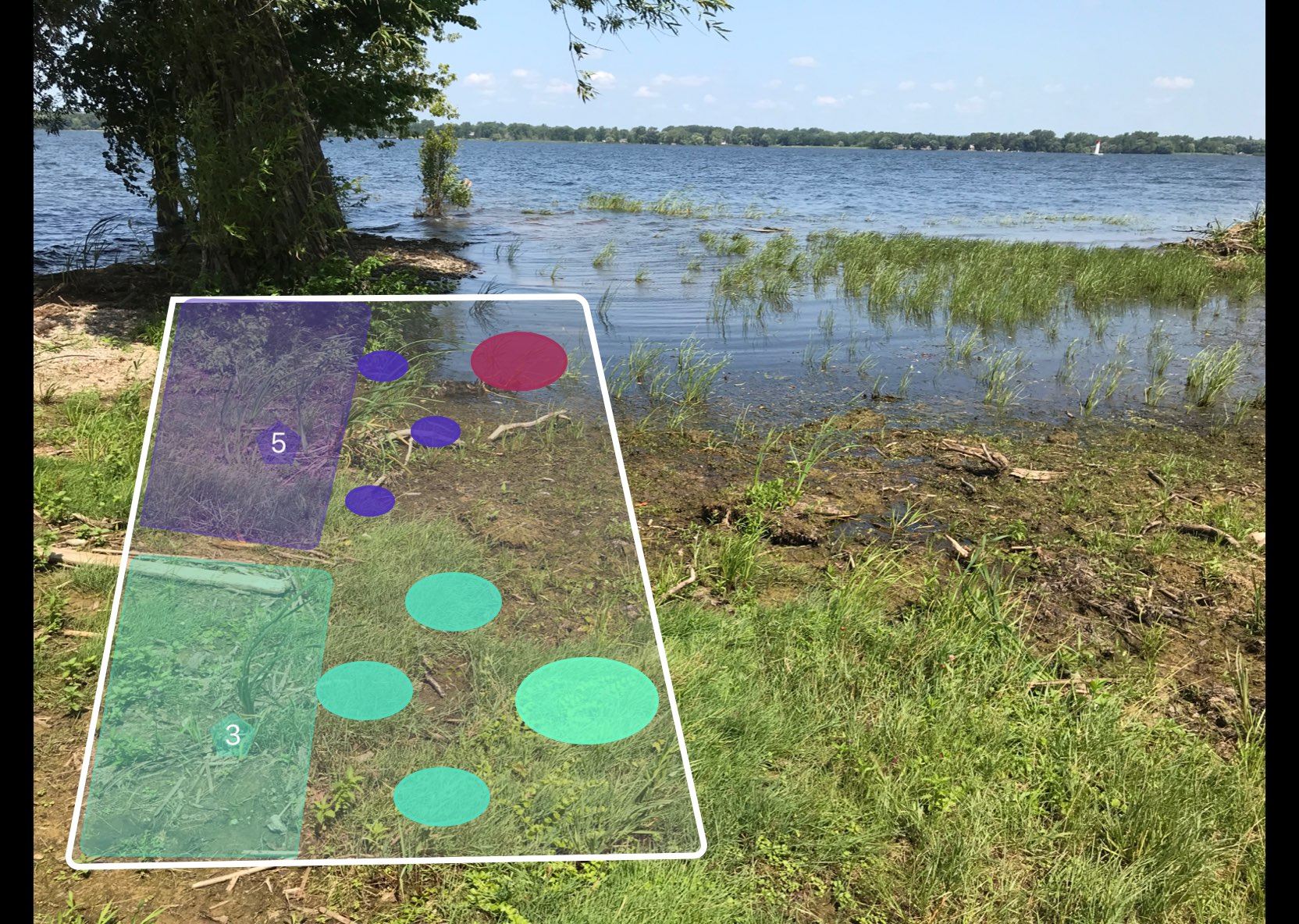
Schedule B
Financial Summary
Project by: Watersheds Canada
Shoreline Re-Naturalization Starter Kit includes: free site visit, customized re-naturalization planting plan for your shoreline property, native plants including free bare root (small) and potted (large) plants and wildflowers, coconut fibre pads to deter grass from growing around new plantings, tree guards for all deciduous trees, mulch for your wildflowers, Plant Care Guide with instructions on how to take care of your new plants, Habitat Creation Guide and a Wildflower Garden Guide.
Our planting plans are created onsite with you and provide detailed information and plans to re-naturalize your shoreline property. We take photos of areas for planting and overlay native plants that are well suited to your property based on site conditions such as soil type and sunlight availability.
We will work with you to create a plan that works for you including options for low growing plants in areas where views are important.
| Item | Quantity | Cost/Item | Subtotal |
|---|---|---|---|
| Starter Kit fee | $0 | ||
| Free potted plants | 15 | $0 | $0 |
| Paid potted plants | 34 | 13.00 | 442.00 |
| Free bareroot plants | 35 | $0 | $0 |
| Paid bareroot plants | 24 | 2.25 | 54.00 |
| Free wildflowers | 9 | $0 | $0 |
| Total costs | 496.00 |
Schedule C
Project Agreement
Stewardship Agreement
Please indicate your agreement to this proposed plan by signing the following Stewardship Agreement and submitting it, along with your financial contribution, to:
Watersheds Canada
115-40 Sunset Blvd. Perth ON K7H 2Y4
Plant Availability
Please note that plant species may need to be changed based on plant stock availability at the time of ordering.
Project Completion
Upon receiving your signed stewardship agreement and financial contribution, a date will be booked for you to pick up your Natural Edge Kit. Watersheds Canada will supply all plants and materials. If you are paying for the planting to be completed for you, a date will be arranged for Watersheds Canada to plant your shoreline, bringing the plants and materials with them. If there are particular dates that you would prefer, we will do our best to accommodate your requests.
The Natural Edge Stewardship Agreement with Watersheds Canada
Agreement made this Day of the Month of in the Year .
BETWEEN Jane Moodey 103 Onderdonk Lane, Carrying Place Ontario (Hereinafter called the OWNERS)
AND Watersheds Canada 115-40 Sunset Blvd. Perth ON K7H 2Y4 (Hereinafter called WC)
WHEREAS the Owners and WC have met and discussed plans for shoreline naturalization on the specified area(s) in Schedule A existing on the Owners’ land;
WHEREAS the Owners indicate approval of the project as proposed; and
WHEREAS the project is, or will be for the benefit of the Owners and others;
NOW THEREFORE THE PARTIES AGREE AS FOLLOWS:
1. This Agreement shall be in effect for a period of 5 years, commencing with the date of this Agreement.
2. The Owners and WC agree that the areas where the work is to be performed is as described in Schedule A.
3. The Owners agree to pick up their Natural Edge Starter Kit from WC’s office and plant their shoreline within two days of receipt. The Owners will provide “after” photos of the work completed to be used for reporting purposes. If the Owners wish to have the planting completed for them, then WC or it’s contractors, employees and agents will complete the planting at cost, as indicated in Schedule B.
4. If the planting is to be completed by WC, then the Owners grant WC, its contractors, employees and agents, the right to enter the property to perform the work agreed upon as outlined in Schedule A. In addition, WC, its contractors, employees and agents may inspect the work performed for the purposes of monitoring the project and survival assessment, with prior agreement with Owners for date and time of inspection.
5. The Owners agree to contribute the “Landowner contribution” and pay the costs indicated in Schedule B.
6. In instances where the Owners are to pay WC for work to be performed (outlined in Schedule A), the Owners agree to provide payments to WC prior to the commencement of that operation. Failure of payment shall constitute a breach of this Agreement and the Owners agree that this Agreement will be terminated and thereupon the Owners agree to pay WC the estimated costs of the operations of the project completed to date, if any.
7. The Owners agree, if necessary, to perform a reasonable amount of maintenance, which is described in the Native Plant Care Guide, available at naturaledge.watersheds.ca.
8. If a contractor is required to perform the work outlined in Schedule A, then the contractor carrying out the work on the land described will be required to take out and furnish evidence of a comprehensive policy of public liability and property damage coverage. The contractor and their workers will be required to be in good standing with the Workplace Safety and Insurance Board (WSIB) prior to performing the work.
9. The Owners agree not to remove, destroy or alter the project without prior consultation and approval of WC. Pruning and trimming planted nursery stock, or adding replacement native nursery stock is exempt.
10. The Owners agree not to mow the planted area.
11. The Owners do acknowledge that WC, its contractors, employees and agents, having performed said works, are not under further obligation with respect to survival of nursery stock, inspection, or maintenance.
12. The Owners, in the absence of negligence, hereby remise, release and forever discharge WC, its contractors, employees and agents from all claims and demands for injuries, including death, loss, damages and costs in any way related to or connected with installation and maintenance of the work described or resulting from any deleterious effects of the work to the land or to the lands and buildings thereon retained by the Owners.
IN WITNESS WHEREOF the parties have agreed to the contents of this plan; SIGNED:
About this program
About Watersheds Canada
Watersheds Canada is a non-profit organization and registered Canadian charity committed to working with landowners, communities, and organizations to protect lakes and rivers through developing effective, transferable, and long-term solutions.
This program was created by Watersheds Canada
We believe that every person has the right to access clean and healthy lakes and rivers in Canada. At Watersheds Canada, we work to keep these precious places naturally clean and healthy for people and wildlife to continue using for years to come. We love working with others to meet the needs of local communities, whether you’re a concerned citizen, a landowner, a lake association looking for help, or a coalition of groups interested in activating your local community.

